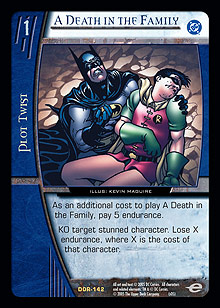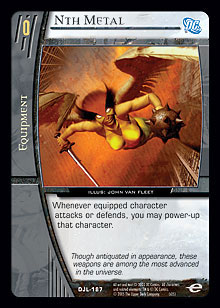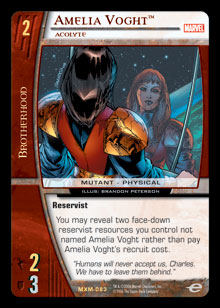
With the release of
X-Men, there is a resurgence of interest in mutants, and not without good reason. All of a sudden, there is a whole set full of powerful evolutionary marvels just waiting to shake up Vs. System come March.
 Ever since the very first experiences we’ve had with the game, Professor X has been battling with Magneto, vying for superiority in Constructed formats. The very first battle was won by the Brotherhood in the starter deck, where various less heroically inclined Brotherhood mutants stomped over the X-Men with relative regularity, getting revenge for all of their comic book defeats. They were led by Magneto, Master of Magnetism, who is still one of the most powerful 7-drops in the entire game. On the strength of aggressive characters and some very powerful plot twists, it frequently wasn’t even close for those of us learning to play in those heady days.
Ever since the very first experiences we’ve had with the game, Professor X has been battling with Magneto, vying for superiority in Constructed formats. The very first battle was won by the Brotherhood in the starter deck, where various less heroically inclined Brotherhood mutants stomped over the X-Men with relative regularity, getting revenge for all of their comic book defeats. They were led by Magneto, Master of Magnetism, who is still one of the most powerful 7-drops in the entire game. On the strength of aggressive characters and some very powerful plot twists, it frequently wasn’t even close for those of us learning to play in those heady days.
This trend of the Brotherhood’s focused aggressive power continued into Constructed, where, along with Fantastic Four beatdown (with more Fantasticars than Thing, Ben Grimm could throw a stick at) and mono-Doom control, it was one of the decks to beat when organized play first began.
From the very first $10K, Brotherhood stood out as the deck to beat when it came to beatdown, be it weenie rush or something a little more curve-tastic. Matt Boccio took home the first big Vs. trophy with a deck focused around The New Brotherhood and quick burn effects like Surprise Attack and The Mutant Menace, winning before control could ever settle into its game. At the $10K at Origins, it was Bill Hodack who walked away with the prize, using the immense power of Lost City and Avalon Space Station to overwhelm opponents in a sea of super power-ups. He defeated Carl Perlas’s Brotherhood combination of the two and firmly cemented which team was to be the first heralded as the “best in the game.”
Here are some lists from that event to give you an idea of how things were “back in the day.”
Eric Wood – New Brotherhood
Characters
3 Lorelei
3 Destiny, Irene Adler
2 Phantazia
3 Toad
3 Avalanche
2 Pyro
4 Rogue, Anna Raven
4 Sabretooth, Feral Rage
3 Blob, Fred Dukes
4 Magneto, Eric Lehnsherr
3 Quicksilver, Speed Demon
Plot Twists
4 The New Brotherhood
4 Crushing Blow
3 Blind Sided
2 Ka-Boom!
1 Not So Fast
4 Savage Beatdown
Locations
4 Genosha
4 Savage Land
Carl Perlas – Medium Brotherhood
Characters
2 Blob
3 Quicksilver, Speed Demon
3 Quicksilver, Pietro Maximoff
4 Pyro
4 Sabretooth, Feral Rage
3 Toad
4 Mystique, Raven Darkholme
2 Mystique, Shape-Changing Assassin
4 Magneto, Eric Lehnsherr
Plot Twists
3 The New Brotherhood
4 Savage Beatdown
3 Not So Fast
3 Flying Kick
3 Ka-Boom!
3 Acrobatic Dodge
Locations
4 Avalon Space Station
4 Lost City
4 Genosha
Bill Hodack – Big Brotherhood
Characters
4 Toad, Mortimer Toynbee
4 Quicksilver, Pietro Maximoff
4 Quicksilver, Speed Demon
4 Mystique, Raven Darkholme
4 Mystique, Shape-Changing Assassin
4 Sabretooth, Feral Rage
2 Sabretooth, Victor Creed
4 Blob, Fred Dukes
4 Magneto, Eric Lehnsherr
4 Magneto, Master of Magnetism
Plot Twists
4 Acrobatic Dodge
4 Overload
4 Relocation
2 Burn Rubber
Locations
4 Lost City
4 Avalon Space Station
One way or another, Brotherhood decks were everywhere. It was like 1984, only twenty years too late. While they didn’t perform as well at the first Pro Circuit in Indianapolis as many Savage Land users might have liked, Sabretooth, Feral Rage and friends remained the choice for discerning beatdown players for a good long while.
 Pro Circuit winner Ryan Jones was the player credited with the most notable tweak to The New Brotherhood archetype. It was the addition of A Death in the Family, which was a very powerful new trick in the “Blitz” version of the deck that already sported plenty of burn. The endurance loss it hit you with was of little consequence, as TNB could quite happily use the extra board advantage it provided to kill opponents before they could feasibly react. In Golden Age, TNB represented “the clock.” It was the fastest deck in the format and you had to have a good plan against it. What made the deck so dangerous was that even with a plan, beating one of TNB’s good draws was pretty tough.
Pro Circuit winner Ryan Jones was the player credited with the most notable tweak to The New Brotherhood archetype. It was the addition of A Death in the Family, which was a very powerful new trick in the “Blitz” version of the deck that already sported plenty of burn. The endurance loss it hit you with was of little consequence, as TNB could quite happily use the extra board advantage it provided to kill opponents before they could feasibly react. In Golden Age, TNB represented “the clock.” It was the fastest deck in the format and you had to have a good plan against it. What made the deck so dangerous was that even with a plan, beating one of TNB’s good draws was pretty tough.
The ultimate downfall of these Brotherhood decks, though, was the lack of any form of search effects to provide consistency. TNB would do its best to overwhelm with a variety of low-costed attackers and its eponymous boost card. Big Brotherhood would max out on characters, knowing that any spares it drew could easily become combat pumps anyway. However, when faced with increasingly powerful decks that could find the answer they needed at the appropriate time (and more dangerous answers, like Unmasked), the fraternity of not-so-good oddballs grudgingly had to take a back seat on the tournament scene for a while.
There were some notable finishes from hybrid decks, including Brotherhood of Assassins (a League of Assassins/Brotherhood deck utilizing The Demon’s Head to find key locations on cue), but it seemed that with the rise of the Sentinels as the efficient beatdown deck of choice, the Brotherhood was down for the count.
Down, but not out.
 Justice League provided the first big boost that the Big Brotherhood archetype had seen in a long time. Nth Metal is simply outstanding with Lost City in play, Kelex is rather nifty at finding appropriate locations to get the offense going, and Straight to the Grave provides much needed character search abilities. This is before I talk about the latest addition to the Vs. System conveyor belt of cardboard delights.
Justice League provided the first big boost that the Big Brotherhood archetype had seen in a long time. Nth Metal is simply outstanding with Lost City in play, Kelex is rather nifty at finding appropriate locations to get the offense going, and Straight to the Grave provides much needed character search abilities. This is before I talk about the latest addition to the Vs. System conveyor belt of cardboard delights.
Yes, the X-Men set has a whole new raft of bad brothers who are very good at what they do, which tends to be attacking for lots. Traditionally, Brotherhood decks have been good at doing the weenie swarm with big attack pumps (TNB) and curving out with powerful characters and power-ups (Big Brotherhood). If JLA revamped the latter archetype, then X-Men definitely adds a lot of power to the former. It also suggests some pretty intriguing new directions for Magneto’s boys and girls.
Unus, despite being more or less a weaker character, saw a fair amount of play in TNB simply by virtue of being a low-cost Brotherhood character who could be played so that the board could get a little busier. For swarm decks, the uniqueness rule is a bit of an issue, so warm bodies are more important than abilities. Unfortunately, Unus’s fifteen minutes of fame are well and truly over. X-Men features some very high quality men with low numbers in the top left-hand corner and quite pleasantly high numbers elsewhere.
Right at the front of the queue are some of the members of the Freedom Force. Not being a massive comic aficionado (I am really quite slim), I am not really sure how the Brotherhood includes a little collection of freedom fighters, but this doesn’t stop me from seeing how nifty these little guys can be when helped out with The New Brotherhood. Pyro, Freedom Force is a perfectly reasonable 1-drop whose ability should kick in often enough to be worthwhile, though he does force you to choose between a 1- and a 2-drop version. Not so with Crimson Commando, who is simply absurd when imbued with an extra couple of ATK points. Free counters for all!
 Amelia Voght and her Acolyte pals also seem to be positive inclusions for an already powerful deck. Reservist is a mechanic with plenty of natural synergy with The New Brotherhood. It allows for easy control of the number of resources you have in play and for copies of The New Brotherhood drawn after turn 4 to get put into the resource row and played to good effect. If Amelia is looking for companion reservists, Kleinstock Brothers is a powerful choice, as is Chrome. There may be issues with working out the proper number of Kleinstock Brothers to run, as traditionally swarm decks don’t like to bulk up on numbers of the same character, but even if its ability doesn’t kick in very often, it’s fair on offense as a 2 ATK / 1 DEF 1-cost character.
Amelia Voght and her Acolyte pals also seem to be positive inclusions for an already powerful deck. Reservist is a mechanic with plenty of natural synergy with The New Brotherhood. It allows for easy control of the number of resources you have in play and for copies of The New Brotherhood drawn after turn 4 to get put into the resource row and played to good effect. If Amelia is looking for companion reservists, Kleinstock Brothers is a powerful choice, as is Chrome. There may be issues with working out the proper number of Kleinstock Brothers to run, as traditionally swarm decks don’t like to bulk up on numbers of the same character, but even if its ability doesn’t kick in very often, it’s fair on offense as a 2 ATK / 1 DEF 1-cost character.
For plot twists and locations, Wundagore Citadel seems a fair choice, working as a reusable source of some extra breakthrough. And Kill the Flatscans has a lot of the merits of A Death in the Family, getting rid of opposing characters for good without costing you any time or board position.
If I were to build The New Brotherhood today (and I am about to), it would look a little something like this:
TNB Redux (The New New Brotherhood)
Characters
1 Thornn, Feral Hunter
2 Pyro, Freedom Force
2 Destiny, Irene Adler
2 Kleinstock Brothers
2 Lorelei, Savage Land Mutate
2 Rem-Ram
1 Avalanche, Dominic Petros
3 Crimson Commando
2 Amelia Voght
1 Chrome
3 Mammomax
1 Rogue, Anna Raven
1 Quicksilver, Pietro Maximoff
1 Silver Sabre, Freedom Force
2 Sauron
4 Sabretooth, Feral Rage
4 Magneto, Eric Lehnsherr
Plot Twists
4 The New Brotherhood
4 No Man Escapes the Manhunters
3 Flying Kick
2 Kill the Flatscans
2 Foiled!
2 Ka-Boom!
1 Blind Sided
Locations
4 Genosha
4 Savage Land
Yes, there are a lot of low numbers in this list, and yes, part of that is because I want to have a spin with lots of the new characters available to the TNB deck. The base is solid, though, and the new cards seem to improve on some of the characters that were just in the deck for their favorable cost before. One thing I can guarantee is that this deck is scarily quick. Be sure to be the person doing the scaring with it, rather than the scare-ee.
What is really exciting is that there are a whole new set of options open to the Brotherhood for those who are tired of doing things the old way or are looking for new ways of playing the team in Silver Age or Marvel Modern Age (for Atlanta, perhaps?). I was blown away by the power of Karl Bown’s Avengers reservist deck at $10K Gen Con UK 2005, and when a tweaked version in the hands of Aaron Weil went 10-0 at PC Los Angeles 2005, it seemed that reservist decks might well be the ones to beat looking forward. As players got used to the power of Squadron Supreme and Faces of Evil, this looked like a less sure thing for Atlanta, but with the Brotherhood reservists in the mix, there might well be a powerful deck out there that cherry picks the greatest reservist heroes and villains for some vicious fun at the next Pro Circuit.
As if it weren’t disheartening enough to face a deck that played a 7 ATK / 6 DEF Black Panther, T’Challa on turn 3, She-Hulk, Gamma Bombshell on turn 5, and Wonder Man on turn 6, now they could be interspersed with Spoor on turn 4, the aforementioned Chrome on turn 2, and Amelia Voght whenever she happens to get drawn! Heroes in Reserve remains as potent as ever, while the characters become that much more aggressive. Am I the only one who thinks it a little ironic that the reservist deck is anything but reserved in its approach to winning the game?
One way or another, the Brotherhood is back, and you are safer joining them than trying to stand in their way.
Have fun and be lucky,
Tim “Is Actually Bigger Than His Big Brother” Willoughby
timwilloughby@hotmail.com